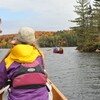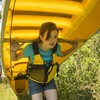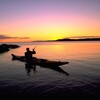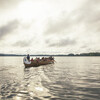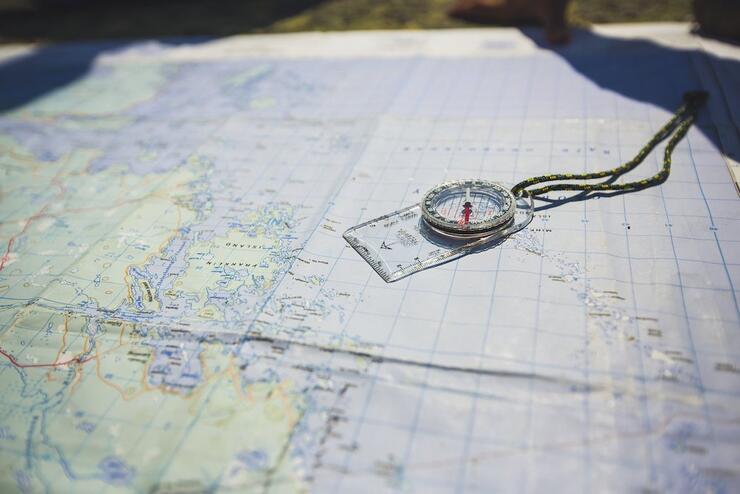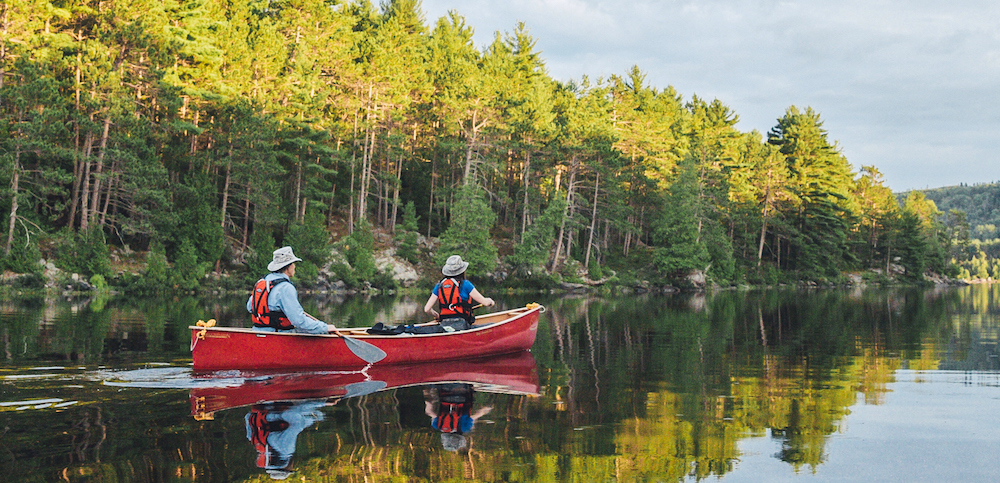Canoe, SUP and Kayak Laws in Ontario

The rules of the high seas—and the low lakes and the rivers running between—are a federal concern. You might just be puttering around a local pond, but the laws governing your outing come from no less an authority than the Canada Shipping Act, 2001.
There’s a lot in there that doesn’t apply to paddlers. The same is true for even the trimmed-down Transport Canada Safe Boating Guide, so we’ve gone ahead and extracted all those sections that might interest—or at least be important to—canoeists, kayakers and stand-up paddleboarders. Safety is key to a successful paddling trip.
If you are new to paddling or need a refresher, check out PaddleSmart. It provides information to help you increase your knowledge, skills and abilities. We also recommend taking a canoe, kayak or SUP course from Paddle Canada.
Kayak and Canoe Laws in Ontario
Given the low speeds and relaxing nature of most human-powered boating, the authorities aren’t so concerned with how you paddle or where you do it. You aren’t going to run anyone over while under paddle power, even in a tandem touring kayak. Broadly speaking, stay sober and out of shipping lanes and you’ll escape the long arm of the law.
So what are the kayak, SUP, and canoe rules in Ontario for? The main area where the law intrudes into paddling activities is in dictating what safety equipment you should have on board. The good news is the rules are, generally, clear and the requirements are not onerous. So if you've been curious to learn what the rules for kayaking are in Ontario, or for canoing or using a SUP, read on.
Below is a list of the equipment you need, with some notes included, because what law doesn’t need some interpretation?
Canoe and Kayak Life Jacket Laws in Ontario
A Canadian Red Cross drowning report showed 88% of drowning victims were not wearing a properly fastened and fitted life jacket or PFD. Some think of PFDs as big, bulky, keyhole-style monstrosities, but modern vests are slim, comfortable and stylish. They won’t flip you over if you are unconscious, but in the eyes of the law they are required safety gear.
The law requires a properly sized PFD on board for each person on a boat. Buoyant “lifesaving cushions” are not approved safety equipment. It’s recommended children always wear their PFDs, but there is no age under which the wearing of a PFD is required by law. Bottom line: responsible paddlers always wear their PFDs on the water.
There are no approved flotation devices for children weighing less than 9 kg. Transport Canada recommends not boating with children under that weight.
PFDs must be marked as Transport Canada-approved. However, tourists can use their own equipment as long as it fits and conforms to the laws of their home country.
Inflatable PFDs are recognized, but with caveats. It’s not enough to just have them on board, they must be worn. Inflatable PFDs are not approved for use in whitewater. Children under the age of 16 or weighing less than 36 kg may not use an inflatable PFD.
The fine for boating without a PFD of appropriate size for each person on board is $200, plus an additional $100 for each missing PFD.
Sound-Signalling Device
Paddlers of all sorts need a “sound-signalling device.” The obvious choice is a whistle, but it needs to be “pealess”—so there shouldn’t be a little ball of cork bouncing around in the air chamber.
Are Canoe and Kayak Lights Required By Law?
Human-powered craft don’t need to have the same red, green and white navigation lights as motorboats, but when paddling between sunset and sunrise or in periods of restricted visibility, such as fog, paddlers must carry a watertight flashlight. Tandem sea kayaks longer than 6 metres must carry six flares.
Heave Ho: Buoyant Line
Paddlers need a buoyant heaving line at least 15 metres long. Purpose-made throw bags are the most practical, but an inexpensive heaving line can be fashioned by fastening a buoyant object to the end of a floating rope. It must be made of one length of rope, not shorter ropes tied together. If paddleboarders and sit-on-top kayakers are wearing PFDs, they aren’t required to carry one.
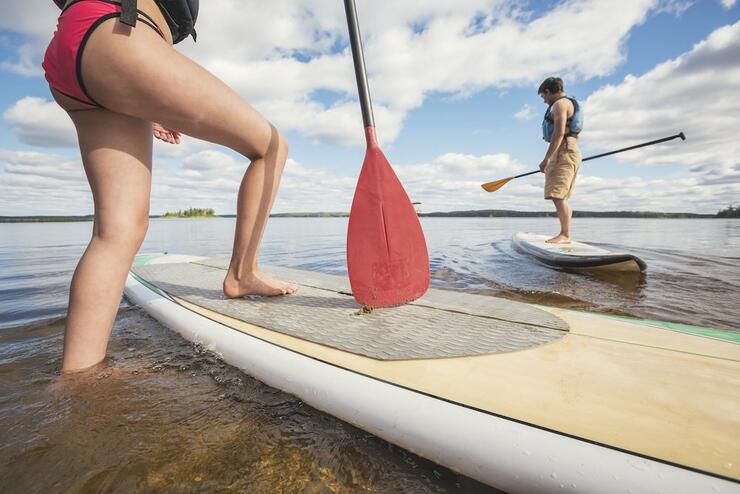
Bail(er) Out
Canoeists and kayakers must pack along a bailer or manual bilge pump. These are not required for a boat that cannot hold enough water to make it capsize.
If paddleboarders and sit-on-top kayakers are wearing PFDs, they aren’t required to carry a bailer. What a PFD-less paddleboarder would do with a bailer remains a mystery.
Bailers must be metal or plastic, hold at least 750 mL, and have an opening of 9 cm in diameter. To its credit, Transport Canada encourages you to fashion your own by cutting the bottom off a 4-L plastic jug (but keep the cap screwed on).
Navigation Needs
A magnetic compass is not required if you are paddling within sight of navigation marks.
Do You Need a Boating License for a Kayak in Ontario?
A Pleasure Craft Operator Card is not needed for canoes, kayaks or SUPs. If you are self-propelled you don’t need to pass any course or carry a plastic card. Just revel in your freedom, responsibly.
Alcohol Consumption and Inebriation
Boating under the influence of alcohol, recreational drugs or prescription narcotics, is illegal in Ontario and Canada. Participating in these activities while on the water can lead to injury or even death.
The Canadian Safe Boating Council (CSBC) hosts Operation Dry Water every summer. The ultimate goal behind Operation Dry Water is to raise public awareness and reduce the incidence of impaired boating. The CSBC also offers a lot of information about canoe and kayak rules in Ontario and Canada on their website.
Do the Canoeing and Kayaking Legal Requirements Apply to Everyone?
Racing boats may not have to carry the equipment listed above if they are engaged in competition, or engaged in formal training and operating under conditions of clear visibility while attended by a safety craft.
For everyone else, failing to have this safety gear on board and easily accessible could earn you a $200 fine.
So best outfit your craft accordingly, because it’s really hard to paddle with handcuffs on. Follow the canoeing and kayaking rules in Ontario to keep you and everyone else safe while on the water.
Recommended Articles
After the Burn

Songs About Canoeing
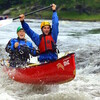
Learn or Improve Your Paddling Skills

The Greatest Lake's Greatest hits

Ontario’s Blue-Water Lakes
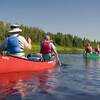
Missinaibi River Canoe Trip
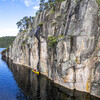
Guide to the Migizi & Iinoo Oowan Trails
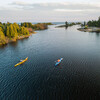
Philip Edward Island Camping Guide

Best Places To Canoe Trip
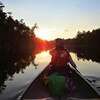
Mattawa River Canoe Trip Guide

Ultimate Guide To Wabakimi
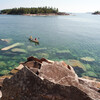
Spectacular and diverse scenery
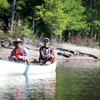
Find Wilderness South of Algonquin

Culinary Canoe Trips

Secret Cascades
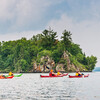
Explore Kenora by Kayak & Canoe

Ultimate Paddling Day Trips
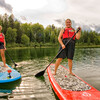
Explore Ontario by Paddleboard

Skip The Crowds
